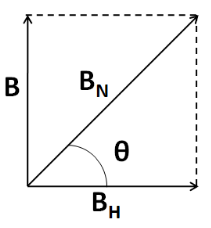
The radius of each coil of a Helmholtz galvanometer is
(A)
(B)
(C)
(D)
Answer
481.8k+ views
Hint: To solve this question, we need to use the formula for the magnetic field produced due to a current carrying coil at its centre. Then we need to use the value of the deflection of the needle to deduce a relation between this magnetic field and the horizontal component of earth’s magnetic field.
Formula used:
The formula used to solve this question is given by
Complete step by step solution:
As there are two magnetic fields involved; one due to the current carrying coils, and the other due to the earth’s magnetic field, so the resultant magnetic field is the vector sum of the horizontal component of the earth’s magnetic field, and the field produced by the Helmholtz coils. We know that the total magnetic field produced by the coils of a Helmholtz galvanometer is given by
The vector diagram for the resultant magnetic field can be represented as below

We know that a magnetic field points in the direction of the resultant magnetic field,
Also from the above figure
We know that
From (1)
So we get the current in the coil as
Now, according to the question we have the radius of each coil
On solving, we finally get the current as,
Thus we get the value of the current equal to
So the correct answer is option A.
Note:
We should not use the formula for the magnetic field which we have used in this solution as the value of the magnetic field on the common axis of the two coils at their mid point. And we also should not use the formula for the magnetic field at the centre of a circular current carrying loop, as it is due to a single coil.
Formula used:
The formula used to solve this question is given by
Complete step by step solution:
As there are two magnetic fields involved; one due to the current carrying coils, and the other due to the earth’s magnetic field, so the resultant magnetic field is the vector sum of the horizontal component of the earth’s magnetic field, and the field produced by the Helmholtz coils. We know that the total magnetic field produced by the coils of a Helmholtz galvanometer is given by
The vector diagram for the resultant magnetic field can be represented as below

We know that a magnetic field points in the direction of the resultant magnetic field,
Also from the above figure
We know that
From (1)
So we get the current in the coil as
Now, according to the question we have the radius of each coil
On solving, we finally get the current as,
Thus we get the value of the current equal to
So the correct answer is option A.
Note:
We should not use the formula for the magnetic field which we have used in this solution as the value of the magnetic field on the common axis of the two coils at their mid point. And we also should not use the formula for the magnetic field at the centre of a circular current carrying loop, as it is due to a single coil.
Latest Vedantu courses for you
Grade 10 | MAHARASHTRABOARD | SCHOOL | English
Vedantu 10 Maharashtra Pro Lite (2025-26)
School Full course for MAHARASHTRABOARD students
₹33,300 per year
Recently Updated Pages
Master Class 4 Maths: Engaging Questions & Answers for Success

Master Class 4 English: Engaging Questions & Answers for Success

Master Class 4 Science: Engaging Questions & Answers for Success

Class 4 Question and Answer - Your Ultimate Solutions Guide

Master Class 11 Economics: Engaging Questions & Answers for Success

Master Class 11 Business Studies: Engaging Questions & Answers for Success

Trending doubts
Give 10 examples of unisexual and bisexual flowers

Draw a labelled sketch of the human eye class 12 physics CBSE

Differentiate between homogeneous and heterogeneous class 12 chemistry CBSE

a Tabulate the differences in the characteristics of class 12 chemistry CBSE

Why is the cell called the structural and functional class 12 biology CBSE

Differentiate between insitu conservation and exsitu class 12 biology CBSE




